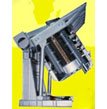|
induction melting furnace
 metals are contained in the coreless furnace by the use of refractory
envelope and surround that by the coil. induction melting furnace
operates on the same basis as a transformer. acting as a single
secondary turn the charge produce heat through eddy current flow when
power is applied to the multi turn primary coil. after the melting of
the metal these electromagnetic forces also produce a stirring action.
through careful selection of frequency and power mixing and melting
rates can be controlled. metals are contained in the coreless furnace by the use of refractory
envelope and surround that by the coil. induction melting furnace
operates on the same basis as a transformer. acting as a single
secondary turn the charge produce heat through eddy current flow when
power is applied to the multi turn primary coil. after the melting of
the metal these electromagnetic forces also produce a stirring action.
through careful selection of frequency and power mixing and melting
rates can be controlled.channel furnace induction channel furnaces are popular induction melting furnace which were used initially as molten metal holders, but are now used for some melting applications as well. it consists of an inductor which is the source of energy and is comprised of a water-cooled coil. for holding metal at temperature, channel induction furnaces are often selected it is the refractory where the channel is formed through the coil, and this channel forms a continuous loop with the metal in the main part of the furnace. the hot metal in the channel is replaced by the cold metals. the hot metal circulates into the main body of the metal in the furnace envelope. source of primary molten metal is required for the startup of a channel furnace. these furnaces do have lower surface turbulence within the main metal bath. in any operations where gas pickup and volatile metal alloy loss is a problem coreless furnace are preferred. coreless frequencies are of following frequencies like:
advantages following are the advantages of induction melting furnace:
induction melting furnace are used for various purposes:
page 2 is inducion melting furnace specifications
|